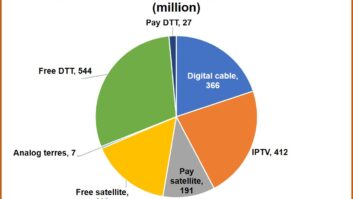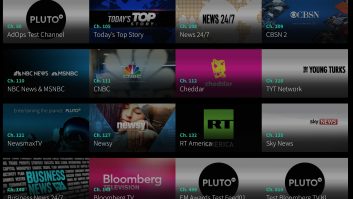Will the impending – critics might say shotgun – marriage of broadcast and broadband take place on a level playing field? Richard Dean examines the wedding vows recently proposed by the European Broadcasting Union to see how the whirlwind romance between traditional media and its new young and glamorous main TV screen companion might endure.
The EBU’s recent ‘Principles for Internet Connected and Hybrid Television in Europe’ recognises great opportunities in the introduction of new platforms and devices that bring television and the internet together.
According to the paper, hybrid systems have the potential to not only expand programme choice and simplify access to internet content for viewers, but also enable European broadcasters and other content providers to link broadcast and on-demand content to provide new forms of enhanced content such as catch-up TV.
However, the EBU acknowledges that the technology prompts a number of questions about the relationship between different players delivering services through the same hybrid platform, not least because of potentially conflicting technical standards and varying regulatory regimes.
We asked Peter Mac Avock (pictured), program manager at the EBU, to elaborate on how the core issues raised in the paper will be resolved, and what mechanisms exist to keep each party on the straight and narrow.
TVBE: After mentioning emerging HbbTV, MHEG-5, MHP and YouView hybrid TV standards, the paper states that ‘Using different technologies in the same market for the same kind of system can become a major barrier to success’. Does this suggest that the EBU believes one of these is better than the others, or that the market should decide?
PM: The EBU is working hard to try and harmonise these different systems. Indeed there are many common elements at the outset, and room for much harmonisation. By being active in all these areas, we can ensure that broadcasters views’ are well-represented and that we can drive maximum harmonisation.
Naturally, the existence of different systems is not an ideal starting point, but there are substantially different requirements in the various European markets. For example, interactive TV is well established on the UK free-to-air platform, but this is not the case in Germany or France.
The EBU believes that consumers’ interests are best served by having common standards where possible, or at least substantially common technical elements shared between them, but the default position of every participant is that the market should decide on standards. Ultimately we believe that all players will want to adopt and develop the widespread use of hybrid TV.
TVBE: Does this mean combining ‘best in class’ characteristics to create a new standard, making existing standards interoperable, or designing consumer equipment capable of working with them all?
PM: It is unlikely that a new standard will emerge from the current discussions – and such a new standard could actually add confusion to an already complex market. Having said that, it’s clear that the standards that currently exist will migrate over time. The key thing is to work to converge these efforts as the market in which they operate converge their requirements.
Wholesale interoperability is not always going to be possible, but there are elements in each standard that could be made interoperable. Applications signalling is one example, content formats is another.
As to equipment working with multiple standards, consumer equipment vendors already supply essentially the same hardware and software to different markets, with regional differences hidden behind installation options.
While this may not always be the case, consumer electronics vendors already support multiple systems, such as MHEG-5 (Multimedia and Hypermedia Experts Group) for interactive functions in the UK and MHP (Multimedia Home Platform) in Italy. There is also room for consumer electronics vendor systems to converge and harmonise.
TVBE: Given the largely unregulated nature of the internet, are there any legal or technical remedies proposed by the EBU to prevent piracy or ‘passing off’ of broadcaster content by internet-based providers?
PM: There are two different aspects involved here. Copyright rules are already in place to provide certain legal remedies in the event of broadcasters’ content being pirated by third parties for their own commercial purposes, so this aspect is not covered by the EBU Principles.
Regarding any possible technical protection of broadcasters’ content against such piracy, the EBU has worked with the broadcast standardisation body DVB to develop the ‘Free-to-Air descriptor’ (ref EN 300 468 V1.11.1§6.2.18), which is designed to cover the signalling associated with content delivered via free-to-air (or free-to-view) broadcasting. The implementation of this descriptor is the subject of some discussion in the UK and other European territories.
However, the EBU Principles do include rules relating to the unauthorised overlay of the screen display by third parties – with advertising messages for example – as this conflicts not only with the broadcasters’ signal integrity but also with viewers’ interests.
TVBE: Similarly are broadcasters protected against unauthorised data capture – or blocking of data to which they feel entitled – by internet service operators?
PM: Access to usage data could become a problem that to our knowledge has not yet been addressed from the legal angle so far.
Data protection rules normally deal with personal data only, including of course personalised usage data, but only from the perspective of protecting the individual to which the personal data refers. It is unclear how general competition rules can be used to resolve these issues.
TVBE: Does the EBU believe that the TV industry should develop its own verification system for web-based audio-visual content, or rely instead on existing search page monitoring?
PM: Here again – as with the issue of piracy – we have to distinguish between regulatory solutions and technical solutions, and indeed both may complement each other. In general we are committed to a technologically neutral approach, irrespective of the platform being broadcast or broadband based. It is also necessary to apply graduated and differentiated rules that are proportional to the level of risk and need for protection.
For example the rules may need to be more robust for free-flowing linear content than for deliberately selected non-linear services, as is already the case with the free-to-air watershed compared to video-on-demand programming. It is clear that where broadcasting and the internet come together on hybrid devices and services, it is not possible to solve the problems arising simply by extending broadcast rules to the whole internet.
But by the same token, it should not be possible to invoke the allegedly unregulated character of the internet to frustrate broadcasting regulation – or media regulation in general – or to evade any other responsibilities with regard to the content made available.
TVBE: ‘Connected TV’ will give consumers access to worldwide TV resources unconstrained by national boundaries. How will the EBU’s Principles be administered?
PM:The EBU Principles are just proposals which are submitted to other stakeholders for consideration and support, and so as a Policy Document rather than a Code of Conduct, the question of enforcement is outside its scope.
However, we would encourage that at least some of the Principles will be taken up voluntarily by the industry, or in industry or multi-stakeholder agreements or charters, or by regulators at national or European level. The means of enforcement will then naturally depend on the instrument chosen.
Editor’s note: The full text of the EBU’s ‘Principles for Internet Connected and Hybrid Television in Europe’ is available at www.ebu.ch under the ‘Position Papers’ tab.







